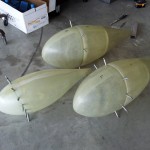It moves, too.
Hours: 2.5 | Posted in Endgame, Gear & FairingsHad the chance to go flying with my hangarmate this morning in his -9A, and despite the thick haze, got a good demonstration of the plane’s performance and abilities. He has 20 more ponies under the cowl than I, plus a constant-speed prop, so we’ll see how mine compares. In the hands of a good pilot, the thing really shines. As in Mike’s plane which I flew earlier this spring, the stall is amazingly docile, and handling is smooth & precise (knowing only the pully-and-yoke system in the C150 where there was always plenty of control slop to go around, it’s probably not difficult to impress me in that regard…) He has cut his sticks down shorter, so that when holding the grip, you’re able to rest your hand/arm on your leg. This was quite comfortable, and the control forces were perfectly fine. (Mine are longer, which was intentional; I decided when working on them to leave them essentially full-length, and cut them down later if desired.)
After the flight, we fired up my engine again and taxied over to the compass rose. On the way, he did the break-in of the brake linings for me, since I’d never seen it done before. Plenty to learn… We stepped through the magnetometer calibration routine on the EFIS, and it came out within a couple degrees. Rob Hickman posted in the AFS support forum that the tolerance of the magnetometer is ±4°, so we’re good to go with that. I taxied back to the hangar and it tracked heading as expected along the way (easy to check since the airport is laid out on cardinal headings…) Many thanks to Jim for doing the grunt work of towing the plane around in a circle in the 90+ heat while I called out directions from the screen.
I also remembered (third time’s the charm) to turn the alternator on for the taxi back, and was able to see that charging current did register, along with a solid 14.5 volts, so it looks like the alternator, shunt, and connections are all ok. I’ll also mention here how handy it is to pull the data logs on an SD card to take home and browse through, to see what I did or didn’t notice in the moment. Mike Behnke (RV-9A) wrote a handy Excel tool to import the logfiles, parse them, and automatically generate data graphs and KML files. Of note: the log and config files don’t do well in a Windows text editor, due to the AFS being a *nix-based system (the line breaks are essentially non-existent for reasons I won’t get into) — but they’re easy to read and edit in Linux, with your favorite editor.
Stood around comparing notes on various things for awhile, and eventually I got down to work on the wheelpants. I was able to get all three of the pants to the “pregnant tuna” stage, with the mating edges of the pant halves sanded square, and drilled together. I need to put together some parts to make a jacking mechanism for the main gear, as I need to pull the wheels in order to install the pant brackets.
Unpacked the intersection fairings I bought a year or so ago, and discovered that they appear to be shaped for the tailwheel model gear, so I was either shipped the wrong set or had a misunderstanding (my order confirmation email does say 6A,7A,9A, though…) Ordered a new set and sent a note about the wrong ones, but since it’s been so long, I expect I’ll end up just posting them for sale to someone who can use these.
Bob Collins (RV-7A) dropped in again for a short visit to share notes & paperwork on the airworthiness packet for the MIDO & DAR. Borrowing those to compare against will be helpful as I put together the necessary forms and info for that process; thanks to Bob for sharing and stopping over in the heat.
Speaking of the heat…long pants were not the best thing to wear today, but I have a habit of holding fibergalss parts on my lap to sand them, which makes covered skin essential. After an hour or so of that, though, I’d about had it, and packed up into the air conditioned truck to go deal with the grocery list of parts & pieces I need. Tomorrow might be a night at home in the shop, deburring and priming the bracketry.
I also believe I have a solution to retain the wingtip hinge pins, that I’ll build.

